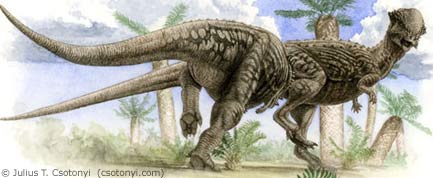Feather Fossils Could Yield Dinosaur Colors

Artists may now be able to paint dinosaurs and ancient birds and mammals in their true colors, thanks to the discovery of pigment residues in fossilized feathers. In recent years, paleontologists have found fossil feathers in about 50 rock formations pegged to dates ranging from the Jurassic period (from about 200 million to 150 million years ago) to the late Tertiary (from 65 million to about 2 million years ago). These feathers are preserved as residues of carbon that were previously thought to be traces of feather-degrading bacteria. A new study of some of these residues, detailed in the journal Biology Letters, found that these microscopic organic imprints are actually fossilized melanosomes, tiny organelles found inside pigment cells that produce melanin pigment. Melanin is what determines our hair, eye and skin color and gives birds' feathers their spectacular range of hues. "Feather melanin is responsible for rusty-red to jet-black colors, and a regular ordering of melanin even produces glossy iridescence," said Yale University graduate student Jakob Vinther, lead author of the study. Vinther analyzed a striped feather found in 100 million-year-old rock from the Lower Cretaceous Period in Brazil. The dark bands of the feather bore the carbon residue, and were similar in size, shape and orientation to eumelanosomes from the black feathers of a Red-winged Blackbird. The light bands in the feather showed no carbon, only the rock surface, indicating the feather had a black-and-white eumelanin pattern. Another fossil of a bird from about 55 million years ago (during the Eocene Epoch), found in Denmark, showed similar traces in the feathers surrounding the skull. The fossil also had an imprint of the ancient bird's eye, which showed structures similar to the melanosomes in the eyes of modern birds. Finding these ancient pigment-producers "demonstrates that melanin can resist decay for millions of years," Vinther said. The research was funded by the National Science Foundation. Feathers from dinosaurs could also preserve melanosomes, the authors say, as could the fur of ancient mammals and the skin of dinosaurs. "Now that we have demonstrated that melanin can be preserved in fossils, scientists have a way to reliably predict, for example, the original colors of feathered dinosaurs," said study team member Richard O. Prum, also of Yale.
- Dino Quiz: Test Your Smarts
- Birds of Prey: Spot Today's Dinosaurs
- Images: Drawing Art
Sign up for the Live Science daily newsletter now
Get the world’s most fascinating discoveries delivered straight to your inbox.

Andrea Thompson is an associate editor at Scientific American, where she covers sustainability, energy and the environment. Prior to that, she was a senior writer covering climate science at Climate Central and a reporter and editor at Live Science, where she primarily covered Earth science and the environment. She holds a graduate degree in science health and environmental reporting from New York University, as well as a bachelor of science and and masters of science in atmospheric chemistry from the Georgia Institute of Technology.









